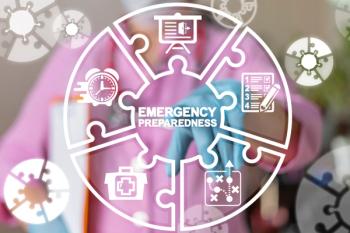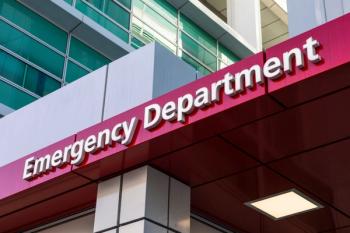
- Psychiatric Times Vol 36, Issue 12
- Volume 36
- Issue 12
Hospital-Level Psychiatric Emergency Department Models
As hospital-based psychiatric emergency programs around the country demonstrate the ability to minimize ED boarding, provide cost-savings, and improve patient outcomes and clinician satisfaction, the challenge will be how to keep these models of psychiatric care self-supporting.
Addressing the Unique Challenges of Highly Acute Patients
Across the country, the past decade has shown a dramatic increase in patients presenting to hospital emergency departments (EDs) with acute psychiatric crises. Between 2009 and 2015 alone, the
According to the Federal Emergency Medical Treatment and Active Labor Act (EMTALA), patients with acute psychiatric conditions that make them either a danger to themselves or a danger to others are considered to have emergency medical conditions (EMCs). Because EMCs are legally equivalent to serious physical ailments, they must be evaluated in emergency departments and cannot be discharged until they are stable and safe, with no further emergent danger.3
Although high-acuity psychiatric crises qualify as medical emergencies, the general emergency department might not be the best location to care for these patients. With the close quarters of the typical ED, its strange lights and sounds, with busy uniformed personnel rushing about, this environment might be disruptive or even worsen symptoms for those suffering from paranoia, despondency, or anxiety. An alternate, hospital-level emergency setting for crisis patients would be preferable. In response, many health systems and communities nationwide have created high-acuity capable psychiatric emergency programs.
Hospital-level psychiatric emergency programs go by different names, including Psychiatric Emergency Services (PESs), Comprehensive Psychiatric Emergency Programs (CPEPs), Clinical Decision Units (CDUs), and more recently, Emergency Psychiatry Assessment, Treatment, and Healing units EmPATH unit). Along with different names, sites might even consider themselves to be a community location rather than part of a general hospital, but all could be considered to provide an EMTALA-compliant, hospital-level equivalent site that can work with most patients regardless acuity of their symptoms. These programs can be part of a general hospital campus, or on the license of a general hospital but located away from the main hospital, or on free-standing psychiatric campuses. They differ in size, scope of services, and environment.
Most programs share the same general philosophy for prompt intervention and targeted, compassionate care: “The Six Goals of Emergency Psychiatry” (also known as “Zeller’s Six Goals”)
1) Exclude medical etiologies of symptoms and ensure medical stability
2) Rapidly stabilize the acute crisis
3) Avoid coercion
4) Treat in the least restrictive setting
5) Form a therapeutic alliance
6) Formulate an appropriate disposition and
Different approaches on how to fulfill these goals has led to various models of emergency psychiatric care facilities, but while no two sites are exactly alike, some basic categories have become evident.
This article is the second in a three-part series on hospital-level psychiatric emergency programs.
Psychiatric Emergency Services or Comprehensive Psychiatric Emergency Programs
Most commonly, a PES (also known as CPEP in some locations) is a distinct hospital operation solely dedicated to managing and treating psychiatric emergencies. Most can accept patients around the clock, either directly from the field via police or ambulance; other times individuals self-present. Some units also may have mobile crisis teams onsite as well as bridge clinics to ensure quick follow-up appointments for discharged patients.
These programs are often affiliated with major academic hospitals or government health systems and work closely with a nearby medical emergency department. It is not unusual for psychiatry residents to provide much of the direct care under the supervision of attending psychiatrists. While numerous variations exist, many programs have individual rooms for patients, similar to an inpatient psychiatric ward, but will attempt to limit stays to less than 24 or 48 hours.
PES programs are considered emergency outpatient programs. They are staffed by psychiatric physicians, advanced providers, nurses, and therapists. Use of physical restraints and injected medication can occur, but they typically occur at lower rates than a medical ED.
In sharing his experiences, Shailinder Singh, MD, Medical Director of the Psychiatric Emergency Room at Metropolitan Hospital in New York City, said: “The Psych ER here provides a vital service to an underserved and often overlooked patient population.”
“As an emergency psychiatrist, I bear witness on a daily basis to gross disparities in access to care for patients who desperately need treatment,” noted Suzanne Bird, MD, who leads the Acute Psychiatric Service in the Emergency Department of Massachusetts General Hospital in Boston. “Being an effective and ethical emergency psychiatrist requires relentless advocacy on behalf of the vulnerable populations we serve.”
Regional dedicated psychiatric emergency programs
While many PES programs are part of a single hospital and have a defined local catchment area of patients, some are designed to be the center of a hub-and-spoke, large district system, a model known as a Regional Dedicated Psychiatric Emergency Program. The prevailing design for these programs is of a stand-alone psychiatric campus, including inpatient beds onsite along with the emergency psychiatric unit. It may feature other onsite programs as well, such as outpatient clinics, drop-in counseling, and partial hospitalization.
Such facilities will accept all emergency psychiatric patients from a widespread geographic area, both directly from the field. They also will receive transfers from a number of area EDs. These centers are somewhat analogous to the relationship between a major trauma center and smaller local hospitals: they are the higher-level-of-care ED that accepts patients with psychiatric emergences from other hospitals. Successful regional dedicated programs are in operation in California and Arizona, and at the Unity Center in Portland, Oregon.
Margaret Balfour, MD, PhD, speaks very positively about the Crisis Response Center in Tucson, Arizona, a stand-alone regional psychiatric program that sees more than 1250 adults and children every month, stabilizing over two-thirds without needing inpatient admissions, and alleviating local ER psychiatric patient boarding. “There are a lot of crisis facilities that don’t take the most acute patients-the highly agitated or violent,” she said. “We want them at our facility, instead of an ED or jail, because we believe that with our staff’s expertise and physical space, we have a much better chance of de-escalating persons in crisis and getting them the treatment they need. It sometimes seems like it’s easier to get into heaven than a psychiatric facility. We try not to put up barriers and instead instill a culture of figure out how to say yes rather than look for reasons to say no.”
Tarak Trivedi, MD, MS, an Emergency Medicine physician at University of California, Los Angeles, published a
EmPATH units
Although proven effective, not every community has the patient volume, funding, personnel, or academic support to operate an expensive 24/7 PES model. Due to recent innovation, distinct hospital-level psychiatric emergency program can still be made available. This scalable solution, known as the EmPATH unit, is now being implemented at sites across North America.
An EmPATH unit is a discrete, independently run program with its own staff, which operates in concert with the ED and under the same hospital license. Because patients are referred only after a medical screening exam in the general ED, a licensed psychiatric provider may not need to be on-site at all times. An on-demand telepsychiatrist can evaluate patients and commence treatment promptly in a cost-effective way, which can result in quick relief of patient distress.
In the most common EmPATH unit model, patients are initially evaluated in a medical ED to rule out or stabilize emergency medical conditions, and then immediately moved to the more therapeutic EmPATH setting.
EmPATH units contain a layout where prompt medical intervention and supervision combine with the best features of community wellness and recovery programs. Individuals are treated concurrently in a large common milieu room, where staff are always interspersed with patients for constant and safe observation and reevaluation. Rather than being assigned to beds, patients choose their own sleeper chairs or recliners, where they can sit up to participate in activities, group or individual therapy, or fold flat to nap. Unlike the necessarily confining arrangement of a typical ED, this design allows individuals to relax, feel comfortable, and move about freely. Easily accessible stations allow patients to get food, drink, or linens without requiring staff involvement or permission. An overall focus on avoiding coercion and causes of frustration has resulted in dramatically lower incidence of physical restraints, aggression, and assaults than more traditional units or EDs, even with a highly acute patient
Now operating in two dozen sites around the nation, the EmPATH unit model contributes significantly to the reduction of ED overcrowding and throughput times by providing prompt transfer to an appropriate psychiatric level of care. Sites typically report 75% or higher avoidance of psychiatric hospitalizations in patients who would have been admitted in more standard ED systems.
EmPATH units are presently working on any scale from eight to 48 chairs; in urban places like Los Angeles or rural settings like Lafayette, Indiana; in academic hospitals or at small community facilities. And given the open floor plan, they can often be created by remodeling an underutilized large room such as a former storage space or shuttered clinic with reasonable conversion costs.
As the Chair of Psychiatry at the Billings Clinic in Montana, Eric Arzubi, MD, led the creation of an EmPATH Unit in April 2018, which today accepts both adults and children, and has led to a substantial reduction in area psychiatric ED boarding and inpatient utilization.
“A well-designed, well-managed EmPATH unit creates value for multiple stakeholders and, most importantly, it improves patient care,” he explained. “At a time when there is a perceived shortage of psychiatric hospital beds, a local EmPATH unit reduces the demand for such beds, allowing the health care system to make more effective use of that precious resource.”
He added, “Public and private payers should be jumping all over this model of care. We found that, due to a lower total hospitalization rate and a decreased 30-day readmission rate, insurers likely saved more than 20% on psychiatric inpatient hospitalization costs. This, in my mind, is among the most powerful examples of value-based care in medicine.”
Taylor Ford, MSW, LISW, is the Assistant Clinical Director of the EmPATH unit which opened in October 2018 at the University of Iowa Hospitals and Clinics. Their 12-chair program has led to a nearly 80% reduction in ED boarding hours, and they have yet to have their first episode of implementing physical restraints, despite a very high-acuity population. “This allows for a more thorough psychiatric evaluation, in which we can work more closely with the individual to develop a safe and supportive plan in a comfortable setting that puts the patient’s needs above all else,” she said. “I can’t tell you how many patients have personally told me that this is the best care they’ve ever received in a psychiatric setting, and that’s exactly what we’re here for.”
Conclusion
As hospital-based psychiatric emergency programs around the country demonstrate the ability to minimize ED boarding, provide cost-savings, and improve patient outcomes and clinician satisfaction, the challenge will be how to keep these models of psychiatric care self-supporting.
In the next and final article in this series, we will review reimbursement issues that psychiatric EDs face and provide strategies to overcome them.
Disclosures:
Dr Zeller is Vice President for Acute Psychiatry with the physician partnership Vituity and Assistant Clinical Professor of Psychiatry, Univesity of California, Riverside, CA. He is an Editorial Board Member of Psychiatric Times.
References:
1. Santillanes G, Lam CN, Axeen S, Menchine MD.
2. Moore BJ, Stocks C, Owens PL.
3. Department of Health and Human Services. Centers for Medicare and Medicaid Services. State operations manual. Appendix V. Emergency Medical Treatment and Labor Act (EMTALA) Appendix V. Interpretive guidelines-responsibility of Medicare participating hospitals in emergency cases. 2010.
4. Trivedi TK, Glenn M, Hern G, et al.
5. Zeller S.
6. Zeller SL.
7. Zeller SL.
Articles in this issue
almost 6 years ago
Paraphilias: From Diagnosis to Treatmentalmost 6 years ago
Illuminate Life Processes by Taking a Sexual Historyalmost 6 years ago
Toward A Bio-Psycho-Social-Eco Model of Psychiatryalmost 6 years ago
Clinical Updates From Bipolar Telehealthalmost 6 years ago
Erotic and Psychological Identitiesalmost 6 years ago
Normal Versus Abnormal Sexual Behavior in Adolescentsalmost 6 years ago
Special Issues in Treating Adolescents With Gender Dysphoriaalmost 6 years ago
LGBTQ Mental Health: What Every Clinician Needs to Knowalmost 6 years ago
Sexting: the Technological Evolution of the Sexual Revolutionalmost 6 years ago
Veterans and Suicide: The Last StrawNewsletter
Receive trusted psychiatric news, expert analysis, and clinical insights — subscribe today to support your practice and your patients.














